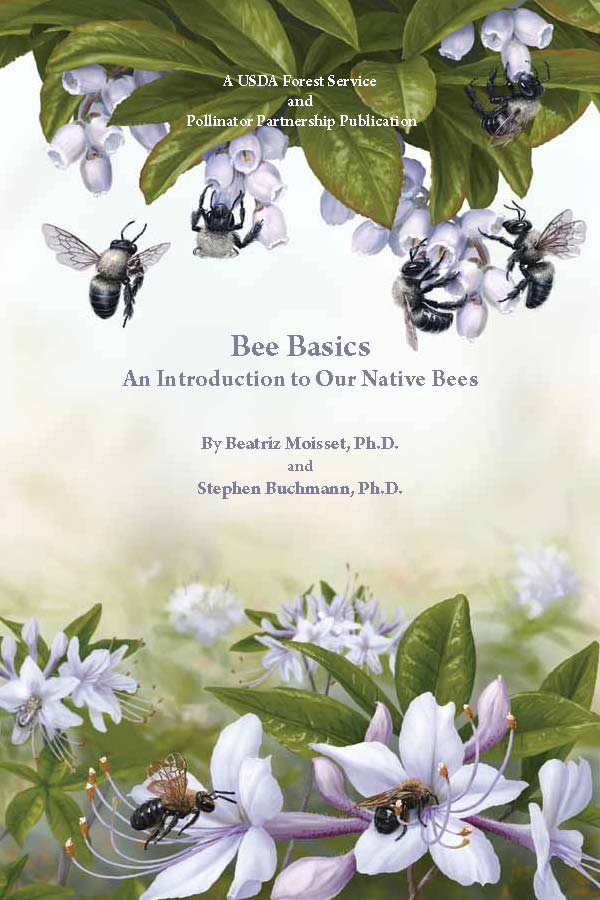- Author: Kathy Keatley Garvey
The late Argentine-born biologist Beatriz Moisset (1934-2022) of Willow Grove, Pa., called the insect "A Pollinator with a Bad Reputation."
Moisset, who received her doctorate from the University of Cordoba, Argentina, and authored the book, Bee Basics, an Introduction to Our Native Bees, was referring to bee flies, from the family Bombyliidae. In their larval stage, these flies parasitize the eggs and larvae of ground-nesting bees, beetles, and wasps.
They superficially resemble bees. If you look closely, however, they have one-pair of wings (bees have two pairs), and their antennae are short and stubby, unlike that of bees.
They neither bite nor sting. Bombyliidae includes some 4500 described species, found throughout North America, Europe and Asia, with many more undescribed.
If you see these long-legged, fuzzy-looking insects, they're usually foraging on flowers or hovering above the ground.
"The reason why it diligently hovers over bare ground early in the spring is that it is looking for bee nests," Moisset wrote in a piece published on the U.S. Forest Service website. "The bees dig tunnels and lay their eggs at their bottoms after collecting enough pollen to feed the larvae. This requires numerous trips, thus the bee fly takes advantage of the mother's absence and lays its eggs in such nests. Making use of its flying prowess, it does not even need to land but it flicks its abdomen while hovering over the open burrow, letting one egg fall in or near it."
"The fly larva finds its way to the chamber where the mother bee has laid the provisions and the egg and proceeds to feed on the stored pollen," Moisset explained. "Afterwards it devours the bee larvae; when it is fully grown, it pupates and stays inside the nest until next spring."
We spotted a bee fly in a Vacaville pollinator on Sept. 19. It zoomed over a yellow zinnia, hovered, and then dropped down to sip some nectar. Meanwhile, looking like a cross between a bee and a fly, it skirted syrphid flies and honey bees also intent on getting their share of nectar.
The bee fly is aptly named.
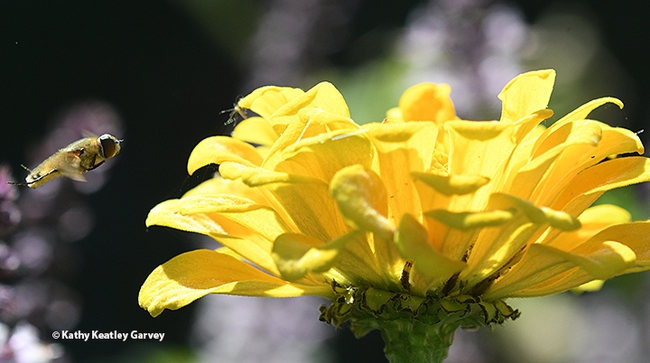
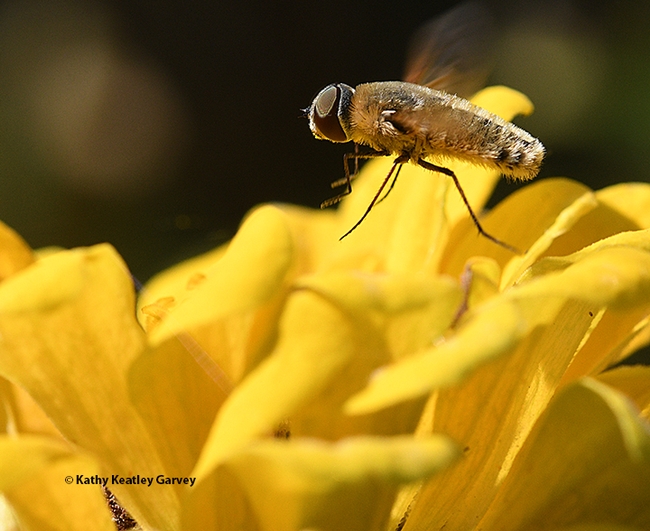
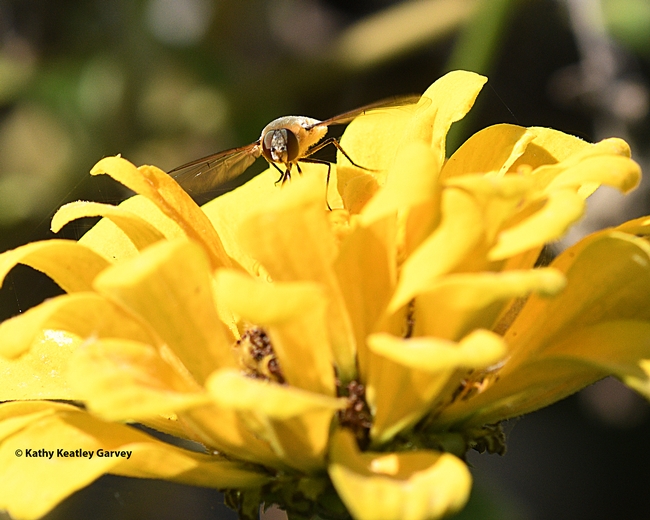
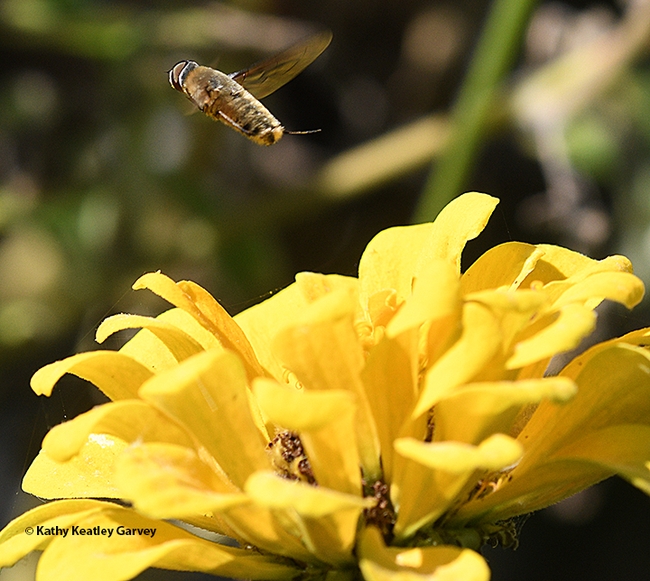
- Author: Kathy Keatley Garvey
Have you ever seen a bee fly, a member of the family Bombylidae?
It's about the size of some bees. It buzzes like a bee. But you can quickly tell it's not a bee by its behavior. It's a fast-moving, long-legged, fuzzylike critter that darts in and around flowers, grabbing nectar on the go, before buzzing off again.
It's curious little insect. Its long tongue (proboscis) is so long you're inclined to say "What? Is that for real?"
It is.
Like a fly, it has two wings (unlike bees, which have four).
We spotted this one pollinating the flowers behind the Lab Sciences Building at the University of California, Davis. The adults feed on nectar and pollen.
In their larval stage, bee flies parasitize the eggs and larvae of ground-nesting bees, beetles and wasps.
Says Wikipedia: "Although insect parasitoids usually are fairly host-specific, often highly host-specific, some Bombyliidae are opportunistic and will attack a variety of hosts."
Biologist Beatriz Moisset, in writing a "Pollinator of the Month" piece for the U.S. Forest Service in celebration of wildflowers, called it "A Pollinator with a Bad Reputation." She also blogs about Pollinators.
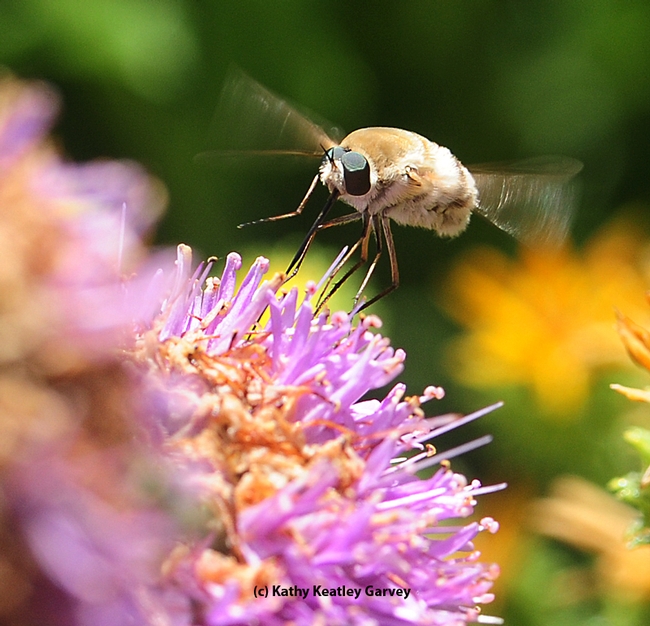

- Author: Kathy Keatley Garvey

On every field trip, we see something new and different, such as the male long-horned bee, Melissodes communis (below) on salvia and the female sunflower bee, Svastra obliqua expurgata, on a Mexican hat flower.
With so much interest in pollinators, it's good to see that biologist Beatriz Moisset has written a downloadable book, "A Beginners Guide to Pollinators and other Flower Visitors." It's meant for young adults and beginners.
Moisset, a resident of Willow Grove, Penn., received her doctorate in biology from the University of Cordoba, Argentina. She completed her postdoctoral work at the Jackson Laboratories, Bar Harbor, Maine, studying neurochemistry and behavior.
She's "retired," but like so many dedicated biologists, she's not. She's a talented artist, photographer, author and public speaker.
Moisset's book, available for a nominal price, covers the most common flower visitors, including pollinators. It includes brief descriptions, illustrations, geographic distribution, habitat and season.
You'll find her insect photography and text on BugGuide.Net and on her pollinator blog, http://pollinators.blogspot.com/. Check out her amazing photos!
And her book? It's available through Barnes and Noble, Lulu.com, and ITunes.
We remember that back in 2011, she teamed with entomologist Stephen Buchmann, who received his doctorate in entomology in 1978 from UC Davis (his major professor was Robbin Thorp), to publish the USDA Forest Service/Pollinator Partnership publication, "Bee Basics: An Introduction to Our Native Bees" with illustrator Steve Buchanan. (Just click on the link to download.)
The more we know about our native bees and the flowers they pollinate, the more we can protect them.
"We are all part of the web of life," Moisset writes on her blog. "Animals need plants and plants need animals and ultimately we all need each other in a very intricate and complex web of interactions."
So true.
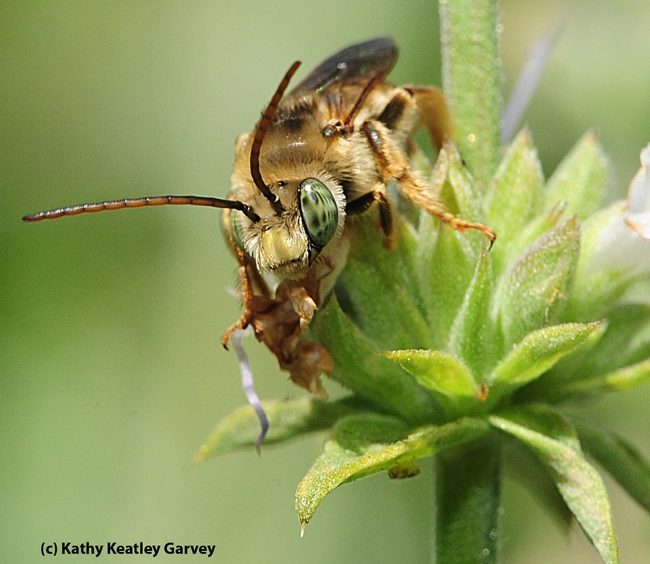
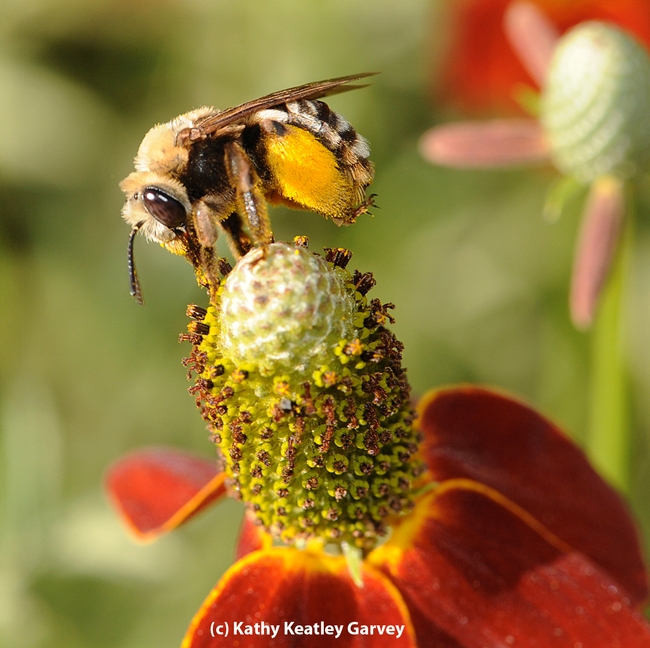
- Author: Kathy Keatley Garvey
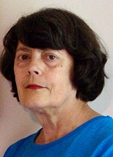
Not all floral visitors are bees.
That's why we're glad to see the publication of Bee Basics: An Introduction to Our Native Bees.
It will introduce folks to such native bees as leafcutter bees, sweat bees and bumble bees.
It's co-authored by retired biologist Beatriz Moisset of Willow Grove, Pa., and entomologist Stephen Buchmann, international coordinator of the Pollinator Partnership, based in San Francisco. The illustrations, based on Buchmann's photos, are by Steve Buchanan of Wingsted, Conn., known for creating the U.S. Postal Service’s pollinator stamps that were issued June 29, 2007.

“From forests to farms, from cities to wildlands, there are 4000 native bee species in the United States, from the tiny Perdita minima to large carpenter bees,” they wrote.
“The honey bee, remarkable as it is, does not know how to pollinate tomato or eggplant flowers. It does very poorly compared to native bees when pollinating many native plants, such as pumpkins, cherries, blueberries, and cranberries.”
The book includes descriptions and illustrations of bees from such families as Apidae, Andrenidae, Halictidae, Megachilidae and Colletidae.
They wrote: “The members of the five most common families, Apidae, Halictidae, Andrenidae, Megachilidae and Colletidae, can be found throughout the North American continent from Canada and Alaska to warm and sunny Florida and Mexico; from forests to deserts; from remote wildernesses to gardens and backyards; even the National Mall in the heart of our nation’s capital sports a native bee fauna. Perhaps the only places where bees are absent are the high mountains.”
“There is even a hardy little bee, the arctic bumble bee, which lives within the Arctic Circle.”
The booklet also offers tips on how to attract pollinators. A great resource!
Steve Buchmann, of Tucson, Ariz., received his doctorate in entomology from the University of California, Davis with major professor Robbin Thorp. Now an adjunct faculty member in the entomology and EEB (Ecology and Evolutionary Biology) departments at the University of Arizona, Buchmann is the author of 150 scientific publications and 12 bbooks, including The Forgotten Pollinators.
Beatriz Moisset, born in Argentina and a resident of the United States for more than 40 years, obtained her doctorate in biology from the University of Cordoba, Argentina. She completed her postdoctoral work at the Jackson Laboratories, Bar Harbor, Maine studying neurochemistry and behavior. A multitalented person (she's an artist, photographer, author and public speaker), she has displayed her pastels and oil paintings at many art shows and contributes her insect photography to the online resource BugGuide.Net.
“I became interested in pollinators after my retirement, combining photography and painting with field observations,” Moisset said.
The book, a USDA Forest Service and Pollinator Partnership Publication, can be ordered from the Pollinator Partnership website for a small donation.
